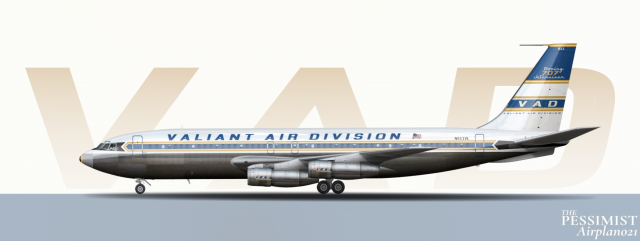
1959 Boeing 707
- Owner: ThePessimist (View all images and albums)
- Uploaded: Jun 26 2022 06:25 PM
- Views: 1,545
- Album Valiant Airways

The war, in addition to substantially changing the character of VAD’s operations and financial standing, also fundamentally changed the character of the commercial airline industry. Even before the end of the war, the roar of the Heinkel He 178’s turbojet echoed far beyond the Western Front. War always brings with it technological progress, but the Second World War brought breakthroughs in countless realms. The DC-4 and DC-6 were the first, but by far not the most significant developments in the world of civilian aviation to come out of the war.
A new, smaller scale war followed the fall of the Axis powers. Manufacturers pumped money into development programs in a race to perfect the first viable commercial passenger jet. De Havilland managed to be first to market but at great cost. However, the lives lost in the Comet’s downing did not deter carriers eager to enter the jet age. Valiant Air Division (VAD) was one of a number of American carriers who reticently ordered jet aircraft, more to compete with other American carriers that planned to acquire jet aircraft than because they were actually interested in upgrading their fleet.
VAD’s small original order for DC-8s was entirely natural given their relatively long business history with Douglas. However, delays in the development of the type combined with a concerted effort from Boeing’s sales department led VAD to cancel its DC-8 order in favour of the 707. Bernard Rogers had never imagined jets in his vision of VAD’s air routes occupying positions as the premiere transatlantic corridor. Jets, though, offered Rogers an opportunity to reinvigorate the Air Division. The rest of VHG, particularly the traditional Great Lakes shipping segment of the business, had been profitable in the postwar years but required immense capital to remain competitive. VAD was simply not as profoundly and consistently profitable as the shipping division and so shareholders preferred that funds go towards the construction of new state of the art freighters rather than aircraft, shipyards, or other infrastructure. Because Rogers’ plans for VAD were never fully funded or realised the carrier did not establish dominance over the transatlantic air market or turn the profits it was promised to bring.
Jets could change the narrative, by offering a shiny new technological advancement to captivate shareholders. One of Boeing's tactics to strike a deal with VAD was allowing Rogers to give tours of their prototype Dash 80 to key VHG shareholders. Part of the jet revolution was ditching the now relatively dated paint scheme which had defined VAD for nearly a decade and a half. The old VAD logo looked too corporate and naval-esque for a truly modern carrier. It was replaced by a flashy modern wordmark and matching extravagant livery. In 1959, to much fanfare, Valiant’s first jet rolled out of Everett in the new paint scheme. VAD’s first jet powered revenue flight was on the Federal Passage route from Detroit to DC. Soon the shareholders, dazzled by the spectacle of the new Boeing fleet, agreed to a large package to fund the expansion of VAD’s domestic network using new jet aircraft. In 1960, VAD inaugurated its first nonstop transcontinental flight running all the way from Detroit to Los Angeles. Later that same year, the carrier also inaugurated transcontinental flights from DC. The flights were successful, partially because they ran with the military efficiency that VHG had adopted in wartime. By 1961, 707s in the new VAD scheme continued to roll off the assembly line displacing older propeller aircraft on long and medium distance routes. The next big plan for the airline was moving from its home in the nation’s capital at DC’s National Airport to the soon to be finished Dulles International. Per contra to the focus on management, something much much bigger was looming on the horizon.

 Sign In
Sign In Create Account
Create Account












